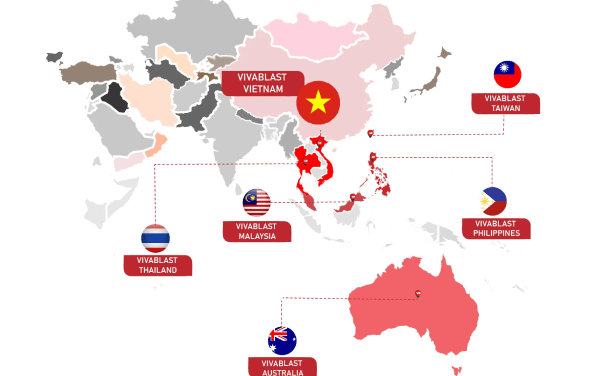As the renewable energy sector continues to grow, wind farms have become a vital source of sustainable power.
However, with their increasing prevalence, many questions arise about their operation, maintenance, and the challenges they face. To provide clarity and expert insights, we sat down with Ms. Duong Thi Ngoc Bich, also known as Ms. Ruby, Key Account Manager (Renewables) at VIVABLAST.
With years of experience in the field, Ms. Ruby answers some of the most frequently asked questions about wind farms, offering valuable knowledge and her perspective on the future of wind energy.

Ms. Duong Thi Ngoc Bich
Ms. Duong Thi Ngoc Bich (Ms. Ruby), Key Account Manager (Renewables) at VIVABLAST, has been playing a crucial role in driving the company's success in the wind energy sector. Her expertise and dedication have been pivotal in the successful completion of numerous wind energy projects, solidifying VIVABLAST's position as a leading provider of sustainable energy solutions.
How does a wind farm work?
Yeah. As basically, instead of using electricity to make wind, like a fan, wind turbines use wind to make electricity. When the wind blows, it turns the blades of the turbines, which then spin a generator to produce electricity. That electricity is then transmitted to power grid, and that’s how it eventually reaches our homes.
What is the potential of electricity generation by wind power?
The potential is actually huge. Wind power could generate far more electricity than we currently use worldwide, but it depends on where the wind farms are located and what capacity the turbines are. Some places are naturally better suited for wind energy because they get strong, steady winds.
How many hours do wind turbines work per day?
Wind turbines can work pretty much whenever the wind is blowing, so it can be anywhere from a few hours to almost all day. On average, they might operate around 12 to 24 hours a day, depending on where they are and the time of year.
Which is more efficient: Wind or Solar power?
It depends on how you define efficiency. Solar panels convert more of the sun’s energy into electricity compared to how wind turbines convert wind energy. But wind turbines can generate electricity day and night, as long as there’s wind, whereas solar only works when the sun’s out.
Are wind turbines a better source of energy than natural gas?
Wind turbines are definitely better for the environment because they don’t produce any greenhouse gases.
However, natural gas is still more reliable because it can provide power anytime. It really comes down to what you prioritize, environmental impact or reliability.
How many wind farms are there in Vietnam?
So, in Vietnam, there are about 146 wind farms under operation right now, with around 8 GW in total, mostly for onshore and near shore wind farms. As per The Power Development Plan from Vietnamese government issued currently in draft form that they are targets to reach 22 GW of onshore and 6 GW of offshore wind installed by 2030.
What are the disadvantages of wind farms?
Well, wind farms do have a few drawbacks. First, they can be pretty noisy, which might bother people living nearby. They also take up a lot of space and can change the look of the landscape, which isn’t always popular with local communities. Another issue is that they can pose a threat to wildlife, especially birds and bats that might fly into the blades. And, of course, wind isn’t always reliable—sometimes it’s too calm or too strong, so you often need other energy sources to fill in the gaps.
How much energy does wind power produce?
Wind power is actually pretty impressive on a global scale. Right now, it produces about 7% of the world’s electricity. In some countries, like Denmark, wind power covers more than 40% of their electricity needs. The amount of energy can vary widely depending on where the wind farms are located and how strong and consistent the wind is in those areas.
How much power does a wind turbine produce per year?
The amount of power a wind turbine produces in a year can vary quite a bit depending on its size and the wind conditions. On average, most of onshore wind turbines have a capacity of 4-5 MW, which can produce over 15 million kilowatt hours of electricity every year, even now the wind turbine capacity can be upto 16 MW. This means it can produce enough electricity to power several hundred homes for a year, depending on the turbine’s capacity and the wind speeds at its location.
How many megawatts can wind turbines produce per year?
To give you an idea, a 3 MW turbine operating at around 35% capacity could produce about 9.2 gigawatt-hours (GWh) in a year, which is 9,200 megawatt-hours (MWh).
How much power can a wind turbine produce?
As mentioned before, the power output varies, but a typical modern turbine has a capacity of 4 to 5 megawatts (MW), and some of the newer, bigger ones can go up to 16 MW.
What is a good definition of wind turbine capacity factor?
The capacity factor is basically a way to measure how much power a wind turbine actually produces compared to its maximum possible output. Think of it as a percentage that shows how well the turbine is performing. If a turbine could potentially run at full power all the time but only runs at half that amount in reality, its capacity factor would be range from 35% to 50%. It gives us an idea of how efficiently the turbine is operating.
What affects the capacity factor of a wind farm?
Yeah there are several things can affect the capacity factor. First, it’s all about the wind speed—strong and steady winds help turbines perform better. The type of turbines used and how well they’re maintained also matter a lot. If the turbines are down for repairs or not operating at their best, it affects the capacity factor. Lastly, how the wind farm is set up, like how the turbines are spaced, can impact their efficiency as well.
Why do wind farms have a low capacity factor of 30%?
Wind farms often have a capacity factor of around 30% because the wind isn’t blowing at the right speed all the time. Sometimes it’s too weak, and sometimes it’s too strong, so the turbines can’t always run at full capacity. Some reason is also mentioned in the previous answer.
How often is there not enough wind to power wind turbines?
Absolutely, how often this happens depends on where the wind farm is located and the time of year.
What’s the typical efficiency of a wind farm?
Between 30% and 40%, this means that wind farms convert about 30% to 40% of the wind’s energy into electricity. This can vary based on factors like wind speed, the design of the turbines, and how well the wind farm is maintained. In areas with really good wind conditions, efficiency can be on the higher than that range.
How to calculate the annual energy yield of a wind turbine?
To estimate the annual energy yield, you take the turbine’s capacity in megawatts, multiply it by the capacity factor, and then multiply that by the number of hours in a year. This gives us a pretty good estimate of how much electricity the turbine will produce in a year.
Is wind power economically viable?
Yes, wind power is becoming more and more economically viable. As technology improves and costs come down, wind energy is now competitive with traditional fossil fuels in many places. Plus, the environmental benefits are a big bonus.
Interested in delving deeper into the wind energy industry? Our team of experts offers comprehensive consulting services tailored to your specific needs. Contact VIVABLAST today.



